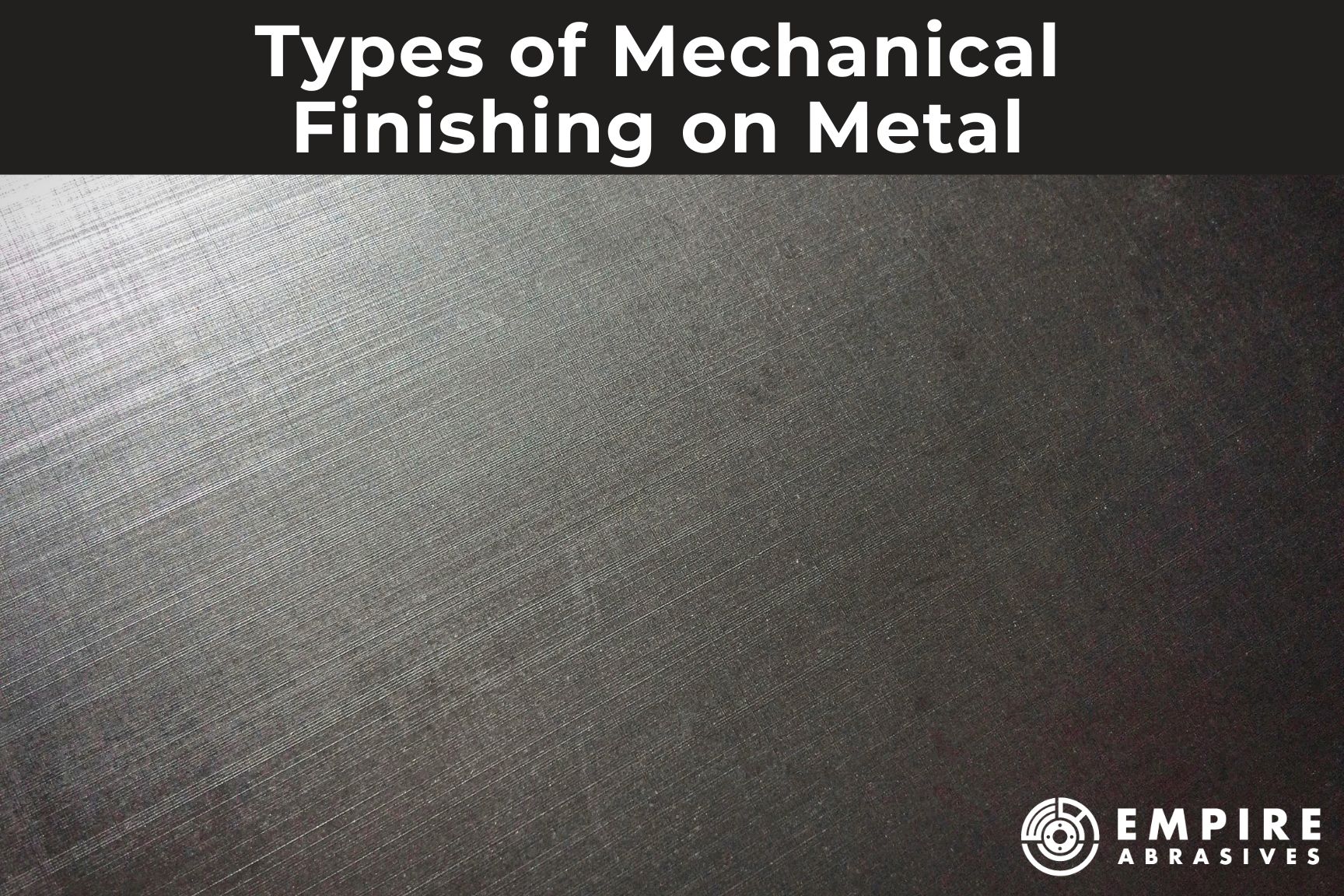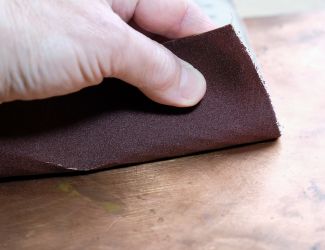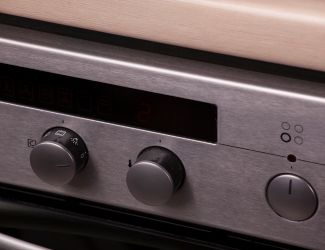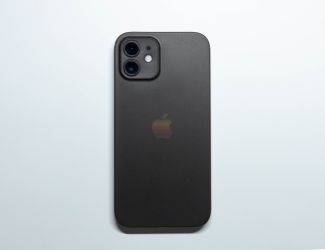
Mechanical finishes have played a major role in metalworking for centuries. It affects both the aesthetics and functionality of different types of metals for all kinds of products. From the sleek lines you’ll see on a stainless-steel refrigerator to the intricate details of a vintage watch, a metal’s finish can transform its appearance, functionality, and even its value.
Today, these finishes are integral in various industries, including automotive, aerospace, consumer electronics, and architecture. They not only improve the aesthetic appeal of metal products but also contribute to their durability, corrosion and rust resistance, and performance.
Jump Ahead:
- What is Mechanical Finishing?
- Reasons for Mechanical Finishing
- Common Mechanical Finishes
- Textured Mechanical Finishes
- Specialized Mechanical Finishes
What is Mechanical Finishing?
Mechanical finishing includes various techniques that alter metal’s surface by physical means, rather than applying coatings or using chemical reactions. This involves using different methods to modify the surface with abrasive products, polishing tools, or specialized instruments. The results of metal finishing can be different textures, patterns, and levels of reflectivity.
Reasons for Mechanical Finishing
Different metal finishes obviously change the appearance of the metal surface, but there are many more reasons why it is done. Here are some of the main reasons it is such an important step in metalworking processes across different industries.
1. Enhanced Aesthetics:
- Visual Appeal: Different finishes transform the appearance of metal surfaces, making them look more polished, refined, and attractive. For instance, a mirror finish can provide a high-gloss, reflective surface, while a brushed finish offers a more subdued, textured look.
- Branding and Differentiation: Unique finishes can become a signature element of a brand, helping products stand out in a crowded marketplace. For example, Apple is known for their sleek, brushed aluminum finish on MacBooks while Rolex incorporates advanced techniques to create unique finishes on their watches.
- Increased Perceived Value: A meticulously finished product is often seen to have higher quality and craftsmanship, increasing its perceived value to consumers.
2. Improved Performance and Durability:
- Corrosion Resistance: Certain finishes, like electropolishing, create a smoother surface that is less susceptible to corrosion, increasing the lifespan of the metal.
- Wear Resistance: Hardened surfaces created by some mechanical processes can withstand abrasion and wear, making products more durable and long-lasting.
- Friction Reduction: Smoother finishes can reduce friction between moving parts, improving efficiency and reducing wear in machinery.
- Heat Dissipation: Some finishes can enhance the heat transfer properties of metal, which can be incredibly important for products like electronic devices.
3. Functional Benefits:
- Electrical Conductivity: Processes like electropolishing can improve electrical conductivity, making finishes crucial for electronic components and contacts.
- Cleanliness and Hygiene: Smooth, non-porous finishes are easier to clean and sterilize. Certain medical instruments and food processing equipment require smoother finishes for health and safety reasons.
- Light Reflection/Absorption: Depending on the finish, surfaces can be engineered to reflect or absorb light, which is essential in optics and solar applications.
- Preparation for Additional Coatings: Mechanical finishing is often done to prep a metal surface for coatings or treatments. A smooth, uniform, contaminant free surface ensures better adhesion of paints, lacquers, or electroplating.
4. Cost-Effectiveness:
- Reduced Maintenance: Durable finishes require less frequent cleaning and maintenance, saving time and money in the long run.
- Material Optimization: In some cases, mechanical finishing can improve the performance of lower-cost materials, making them suitable for demanding applications.
Common Mechanical Finishes
Satin Finish

A satin finish provides a smooth non-reflective surface with a subtle sheen. It is less glossy than a mirror finish but more reflective than a matte finish (both mentioned below).
Process of Achieving a Satin Finish:
Satin finishes are achieved by brushing the metal with progressively finer abrasives or by using tools like sandpaper, sanding belts, or wire wheels. Final steps usually include polishing compounds and buffing wheels to remove any lines or imperfections created from sanding.
Common Applications and Benefits:
- Applications: Satin finishes are popular for everyday items like cutlery, bathroom fixtures, jewelry, and modern furniture.
- Benefits: This is popular for its ability to hide fingerprints and minor scratches, making it easier to maintain in high-traffic areas and for everyday items. It also provides a modern, sophisticated look that enhances the aesthetic appeal of various products.
Mirror Finish

A mirror finish, as it says in the name, creates a highly reflective surface that acts like a mirror. This finish offers the highest level of shine and reflectivity achievable on metal surfaces.
Polishing Process for Mirror Finish:
To achieve a mirror finish, the metal surface is polished using progressively finer abrasives. The process may include several stages of buffing with different buffing and polishing compounds to eliminate any imperfections and achieve a high level of reflectivity.
Read more:
- How to Polish Aluminum to a Mirror Finish
- How to Polish Stainless Steel to a Mirror Finish
- How to Buff and Polish Brass to a Mirror Finish
Common Applications and Benefits:
- Applications: Mirror finishes are commonly found in decorative items, high-end consumer electronics, high-end jewelry, and automotive parts.
- Benefits: The main advantage of a mirror finish is its stunning visual appeal, which adds a luxurious and high-quality look to products. The smooth surface is also easy to clean and maintain, making it suitable for environments where hygiene is important.
Polished Finish
A polished finish sits between a satin finish and mirror finish. The surface is bright and smooth, but not so far as to get a mirror-like reflection. Polished finishes are often easier to achieve than mirror finishes and can be more practical for everyday use.
Polishing Process and Tools:
Achieving a polished finish is similar to the process used for mirror finishes but will involve less stages and lower grit abrasives. The metal is polished using a series of abrasives, sanding discs, and polishing compounds until the surface reaches the desired smoothness and reflectiveness.
Common Applications and Benefits:
- Applications: Polished finishes are used in a wide range of applications, including kitchen utensils, automotive parts, and industrial equipment.
- Benefits: This finish enhances the metal’s aesthetic appeal while providing a surface that is relatively easy to clean and maintain. It also offers improved resistance to corrosion and wear.
Brushed Finish

You will recognize a brushed finish by its characteristic fine, parallel lines that create a distinctive grain pattern on the metal surface. The direction of the brushing can be varied to create different visual effects.
Process of Achieving a Brushed Finish:
Satin finishes are achieved by grinding the metal with an abrasive material (often a wire brush or abrasive pad) in a single direction. The coarseness of the abrasive material determines the depth and width of the lines.
Common Applications and Benefits:
- Applications: Brushed finishes are a very popular style for kitchen appliances. It is also commonly used in modern architecture and design, the automotive industry, and consumer electronics.
- Benefits: This finish is popular for its ability to conceal fingerprints and minor scratches, making it ideal for products that are frequently handled or exposed to wear. The textured surface also provides a contemporary and professional appearance.
Matte Finish

A matte finish is a smooth non-reflective finish that absorbs light rather than reflects it. This gives the metal a subdued flat appearance. This finish is achieved by treating the metal surface to diffuse light and reduce shine.
How to Achieve a Matte Finish:
There are various techniques for creating a matte finish on metal surfaces including sandblasting, grinding, brushing, polishing with matte compound, and vibratory finishing.
- Sandblasting/Bead blasting: Abrasive media is propelled at high velocity to create a uniform matte texture. The degree of coarseness can be controlled by the choice of media and the intensity of the blast.
- Grinding: Using abrasive belts or wheels, grinding can create a matte finish with varying degrees of roughness. The coarser the grit of the abrasive, the rougher the finish.
- Brushing: Wire brushing with a fine-grit brush creates a directional, matte finish with a subtle sheen. The direction of the brushing can be varied to create different patterns.
- Polishing with a Matte Compound: Certain polishing compounds are designed to produce a matte finish when used with a buffing wheel. These compounds contain fine abrasives that smooth out the surface while minimizing shine.
- Vibratory Finishing: This method involves tumbling the metal parts with abrasive media in a vibrating container. The rubbing action creates a smooth, matte finish.
Common Applications and Benefits:
- Applications: Matte finishes are often added to photography equipment, high-end electronics, jewelry, and luxury goods.
- Benefits: Matte finishes are ideal for electronic displays and instrument panels due to their non-glare properties, which is also crucial for photography equipment. They offer a luxurious appeal and are less likely to show fingerprints and smudges compared to glossy finishes.
Textured Mechanical Finishes
While smooth finishes like satin and mirror are popular, textured finishes offer unique aesthetic and functional properties. These finishes create distinct surface patterns that can enhance grip, provide a more rugged look, and create unique patterns and tactile feelings.
Bead Blasted Finish
Process explanation and surface effects:
Bead blasting is a surface treatment method that involves propelling small spherical media (typically glass beads) at high pressure against a metal surface. This process creates a uniform, finely dimpled texture across the entire surface.
Resulting texture and appearance:
Bead blasting produces a smooth, non-directional matte finish that is both visually appealing and functional. The appearance is often reminiscent of frosted glass. The resulting texture can vary from fine and subtle to coarse and rough, depending on the desired outcome.
Common Applications and Benefits:
- Applications: Many high-end watches use bead-blasted finishes for a modern, understated look. It is also often used in automotive components, aerospace parts, medical devices, and consumer electronics.
- Benefits: Bead blasting creates a non-reflective surface ideal for applications where glare reduction is important and its textured surface offers improved paint adhesion. Bead blasting can also harden the metal surface, improving its durability and resistance to wear.
Sandblasted Finish
Similar to bead blasting, sandblasting involves propelling abrasive media at high velocity towards the metal. Instead of glass beads, sandblasting typically uses sand, aluminum oxide, silicon carbide, or other abrasive grain. This results in a rougher, more grainy texture than bead blasting.
Resulting texture and appearance:
Sandblasted finishes create a distinctive, textured surface that can range from fine and subtle to coarse and abrasive. The specific texture depends on the type of abrasive media used and the blasting intensity.
Common Applications and Benefits:
- Applications: Sandblasted finishes are commonly used in industrial machinery, outdoor structures, automotive parts, and artistic projects. It is also used in preparing surfaces for painting or coating.
- Benefits: The unique advantage of a sandblasted finish is its ability to provide a non-slip texture. The process helps to hide surface imperfections and can improve paint adhesion.
Hammered Finish
A hammered finish creates a series of small, shallow indentations across the metal surface, resembling the effect of repeatedly striking the metal with a hammer. This results in a highly textured, almost dimpled appearance that scatters light in interesting ways. This finish is often used to add a rustic, vintage, or artisanal feel to products.
How to Achieve a Hammered Finish:
Hammered finishes can be achieved through various methods, including manual hammering, automated hammering machines, or specialized tools that imprint a hammered texture onto the metal surface.
Common Applications and Benefits:
- Applications: Hammered finishes are commonly used in decorative metalwork, jewelry, kitchenware, architectural elements, furniture design, and home decor.
- Benefits: Hammered finishes create a unique aesthetic appeal, hide scratches and dents, and improve heat distribution in cooking applications.
Specialized Mechanical Finishes
While the mechanical finishes we mentioned above offer a wide variety of options, the specialized techniques take metal finishing to the next level. These intricate processes often require advanced technology or skilled craftsmanship, resulting in unique patterns and enhanced functionality.
Etched Finish
Etching involves selectively removing material from the metal surface to create patterns or designs. This can be done through acid etching or laser etching. Etched finishes are often used for decorative purposes in jewelry and signage, or for creating functional micro-textures.
Engine Turned Finish
Also known as guilloché, this finish creates intricate, overlapping circular patterns on metal surfaces. It's commonly found in high-end watches, luxury car interiors, and decorative metalwork. The unique pattern catches and reflects light in interesting ways, adding depth and character to the metal surface.
Knurled Finish
Knurling creates a pattern of raised diamonds or straight lines on a metal surface, primarily to provide a non-slip grip. It's commonly used on tool handles, equipment knobs, and exercise equipment. Besides its functional benefits, knurling can also add a decorative element to parts.
Ready to Transform Your Metal?
At Empire Abrasives, we understand that choosing the right finish for your project is crucial. Our team of abrasive experts is ready to guide you through the selection process, offering personalized advice and recommendations based on your specific needs and goals.
Have Questions?
Our abrasives experts are available during office hours to answer any questions you may have about mechanical finishes or abrasive products. Reach out to us by phone, email, or chat and we'll be happy to help. If you reach out during off-hours, leave a message and we’ll get back to you promptly the next business day.
Fast and Reliable Shipping
We understand that your projects can't wait. That's why we offer lightning-fast shipping with most orders dispatching within 1 business day. Order your metal finishing products today!
